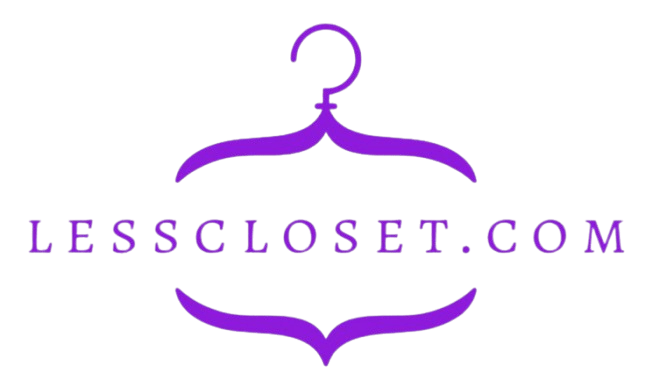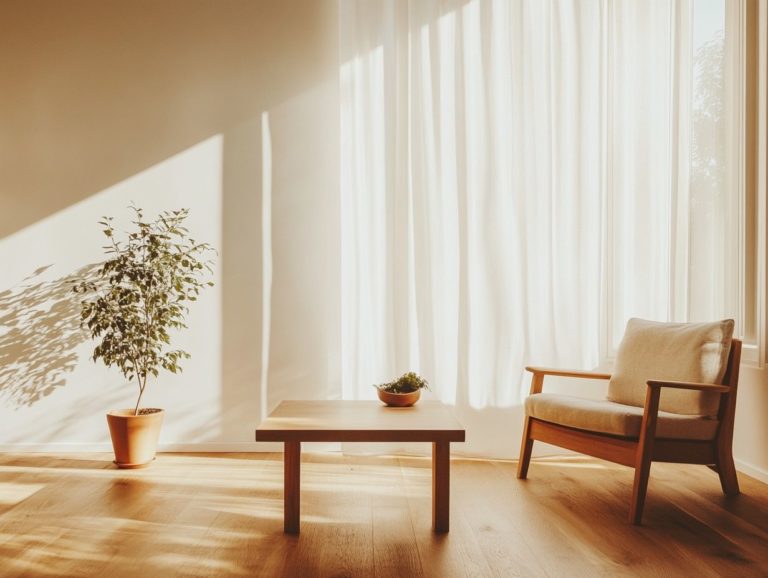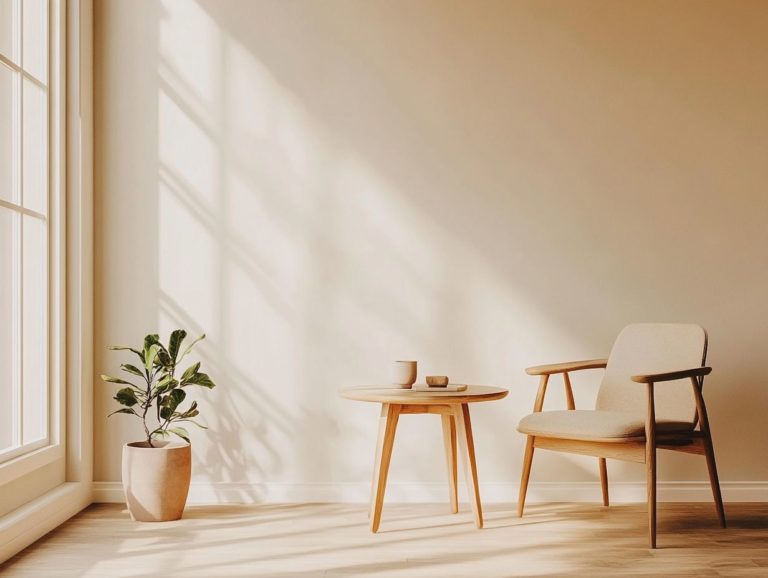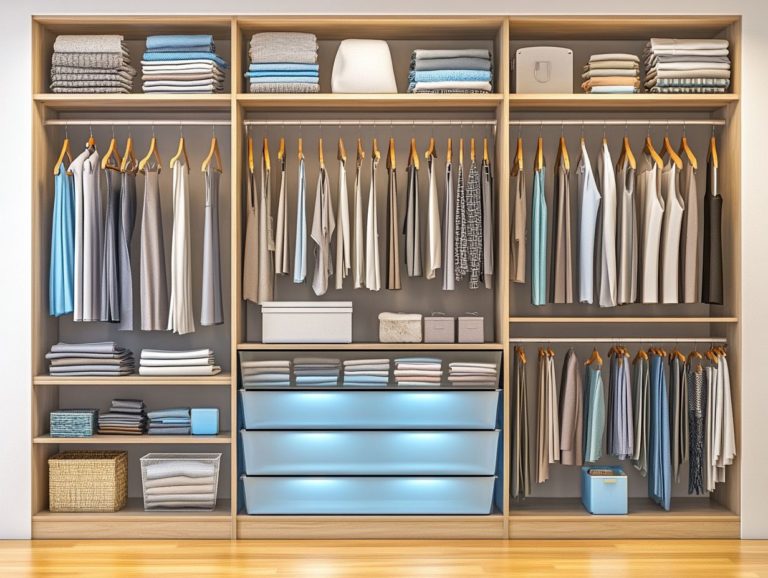What You Need to Know About Building a Minimalist Closet
Ready to simplify your life? Let’s dive into minimalism!
Contents
Key Takeaways:
- Embrace minimalism by defining it as a lifestyle and understanding its benefits.
- Building a minimalist closet has numerous personal and environmental benefits.
- Take steps to create a minimalist closet by assessing your wardrobe, identifying essential items, and organizing your clothing. Avoid impulse purchases and regularly reassess your wardrobe to maintain a minimalist closet.
The Basics of Minimalism
Minimalism is a lifestyle choice that emphasizes simplicity and intentionality. It encourages individuals to prioritize essential items over excess. This approach alleviates decision fatigue in daily life and promotes a sustainable fashion mindset, focusing on high-quality clothing that lasts.
By incorporating a minimalist aesthetic into your living space and wardrobe, you create a harmonious environment that boosts your mental clarity and overall well-being.
Why You Should Build a Minimalist Closet
Creating a minimalist closet helps you express your personal style and has positive environmental impacts by reducing the fashion industry’s negative effects on the planet.
A minimal wardrobe composed of high-quality garments makes outfit planning easier and minimizes wardrobe gaps. This ensures you have versatile pieces that reflect your chosen personal uniform.
Embracing sustainable fashion through methods like secondhand shopping and community clothing swaps encourages a thoughtful approach to selecting clothing items.
Steps to Building a Minimalist Closet
The most effective way to build a minimalist closet is to approach the process step by step.
Start by conducting a wardrobe audit to identify the various clothing categories you have and the essential pieces you truly need. This will help you create a capsule wardrobe, which is a small collection of clothing that works well together, simplifying outfit planning.
By prioritizing quality over quantity, you ensure that each item in your closet is functional and brings you joy.
Assessing Your Current Wardrobe
Assessing your current wardrobe is the first step toward embracing minimalism. Examine your clothing to identify essential pieces and any gaps that need to be filled. Reflect on how you manage your clothing and determine which items you wear frequently and which ones you rarely touch.
Effective wardrobe audits provide valuable insights into what you truly need by categorizing clothes into sections such as work, casual, and special events. This makes it easier to evaluate aspects like fit, fabric, and functionality.
Ask yourself whether you truly love or need each item. Pay special attention to pieces you haven’t worn in a year, as this may indicate gaps in your wardrobe that you hadn’t previously recognized.
By streamlining your selections based on quality rather than quantity, you clarify what you need for your current lifestyle and cultivate an effortless style.
Identifying Essential Items
The most essential items in your wardrobe form your personal uniform, comprising versatile pieces that can be styled in numerous ways. Aim to include timeless clothing that is not tied to a specific season and can serve multiple functions.
To identify these essential pieces, consider your personal style and reflect on colors and shapes that align with your lifestyle. Functionality is key—look for items that can transition effortlessly from work to evening events.
Generally, invest in foundational pieces such as a tailored blazer, classic jeans, and versatile tops that are not only trendy but also enduring over time.
Organizing and Storing Your Clothing
The role of organization in achieving minimalism in your closet is crucial. Effective storage solutions help with decluttering and make clothing maintenance easier.
An organized wardrobe that maintains visual symmetry allows you to find and select your favorite outfits quickly. This ensures everything remains tidy and efficient.
Use vertical space through shelving units or cascading hangers to maximize your storage potential. Use storage bins or baskets for off-season items to keep your closet looking neat.
Regularly purge unworn items to maintain organization. Organizing garments by color or category enables quicker selection and creates a calming atmosphere.
Invest in quality hangers and clothing care products now to preserve your favorite wardrobe pieces and reduce daily maintenance. An organized environment fosters a sense of calm and promotes sustainable fashion practices.
Tips for Maintaining a Minimalist Closet
To maintain a minimalist closet, frequently reevaluate your shopping habits. Prioritize essential clothing items and utilize capsule wardrobe strategies.
These approaches help reduce the amount of clothing you own and minimize decision fatigue when choosing outfits.
Avoiding Impulse Purchases
Strategies for avoiding impulse purchases are essential for a minimalist closet. Adopt mindful shopping habits that prioritize intentional buying and sustainable fashion choices.
Be aware of your wardrobe gaps and focus on the right clothing items. This will lessen the likelihood of being swayed by fast fashion.
One effective way to prevent impulse purchases is by setting limits on shopping. Establish a budget to control impulse spending and encourage deliberate purchases.
Create a wishlist to evaluate clothing items over time, ensuring you only acquire pieces truly needed for a cohesive wardrobe.
Avoiding impulse purchases helps curate a collection of quality fashion items that align with your personal style, without unnecessary excess. Intentional shopping habits are key to building a minimalist wardrobe.
Regularly Reassessing Your Wardrobe
Periodic audits of your clothing are essential for ensuring your wardrobe aligns with your evolving personal style and seasonal needs. Conduct these audits to maintain an organized wardrobe and reinforce minimalism.
By assessing your clothing, you can determine which pieces fit your style and which should be discarded or donated. This process clears valuable closet space and facilitates the seamless addition of seasonal items for enhanced versatility.
When planning an audit, select a specific timeframe—like transitioning from summer to fall—to focus on how well each piece complements your desired aesthetic for the upcoming season.
Embracing minimalism encourages mindful purchasing, making it easier to curate a cohesive collection of clothing that looks good together without clutter.
How Fashion Impacts Our Planet
The fashion industry significantly impacts the environment by contributing to pollution, waste, and resource depletion. Implementing sustainable fashion solutions can help mitigate these issues.
By purchasing high-quality clothing and participating in community clothing swaps, you can reduce your carbon footprint and promote sustainable clothing care.
Join the movement for sustainable fashion today!
Embracing Sustainable Practices
Sustainable practices play a crucial role in building a wardrobe. They promote a commitment to ethical fashion and environmental sustainability. This includes secondhand shopping, ethical-brand shopping, and organizing your wardrobe to preserve the life of your clothing.
Shopping secondhand can be done through thrift stores, consignment shops, and online resale platforms. This often leads to discovering unique pieces with a story while reducing waste in the fashion industry.
Ethical-brand shopping means supporting brands that use sustainable materials, which are good for the environment, and ensure fair working conditions. Many of these brands also support artisans and communities around the globe.
Proper care for clothing helps extend their lifespan. Learning how to wash, store, and maintain garments reduces the need for replacements.
Frequently Asked Questions
What is a minimalist closet?
A minimalist closet is a wardrobe with a limited number of essential and versatile clothing items, typically 25-50 pieces. The goal is to reduce clutter and promote a more intentional and sustainable approach to fashion.
Why should I build a minimalist wardrobe?
Building a minimalist closet saves you time, money, and mental energy. It reduces decision fatigue and allows you to focus on quality over quantity.
This approach promotes a sustainable and eco-friendly lifestyle by minimizing excessive consumption.
How do I start building a minimalist wardrobe?
Begin by decluttering your current wardrobe. Set aside items you no longer wear or that don’t fit your style.
Then, assess the remaining items to identify your must-have clothing items and versatile pieces. These will form the foundation of your minimalist wardrobe.
What types of must-have clothing items should I include in a minimalist closet?
A minimalist closet typically includes high-quality, timeless, and functional clothing. Choose pieces that can be mixed and matched to create various outfits.
This may consist of some basic tops, bottoms, outerwear, and shoes. The key is to select items you love and feel comfortable wearing.
How often should I update my minimalist wardrobe?
The beauty of a minimalist closet is that it requires less frequent updates. Focus on building a timeless wardrobe that lasts for years.
You may occasionally add a new seasonal piece or replace a worn-out item, but aim to maintain a small and intentional collection.
Can a minimalist wardrobe work for all seasons?
Yes! A minimalist wardrobe can work for all seasons. Choose versatile pieces that can be layered and styled differently based on the weather.
For example, a lightweight sundress paired with a cardigan and boots works for fall, while a t-shirt under a jacket suits winter.
Ready to transform your closet? Have more questions? Let’s dive deeper into your fashion journey!





